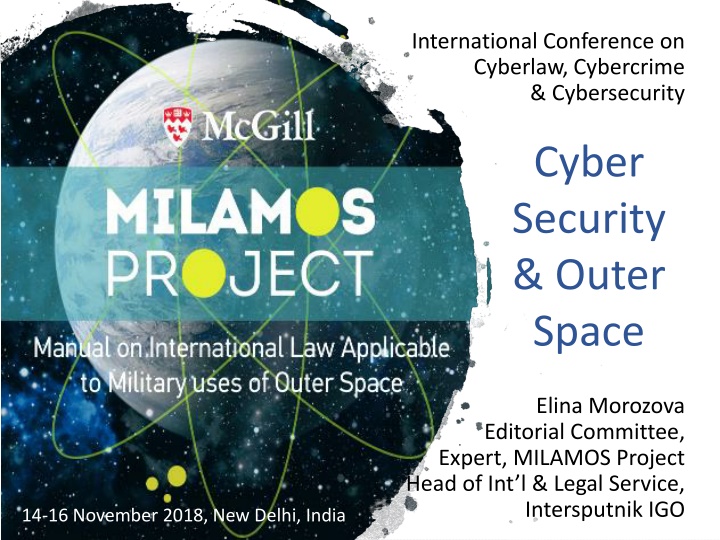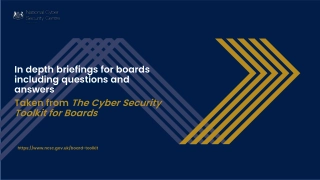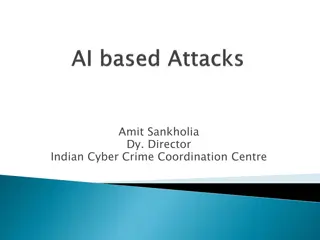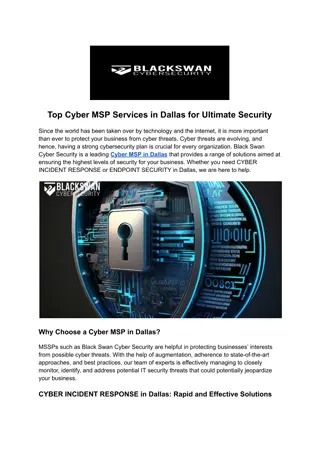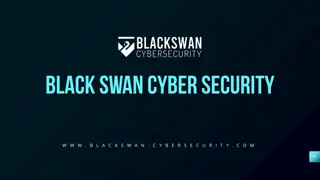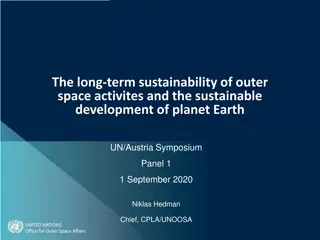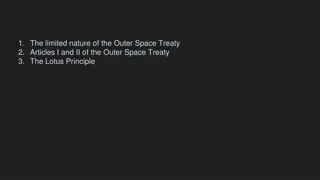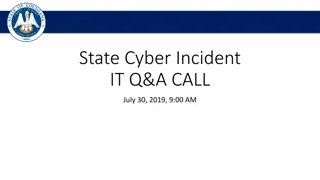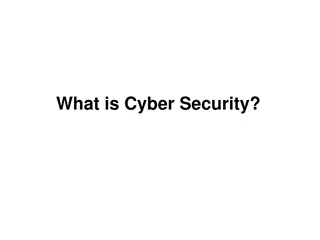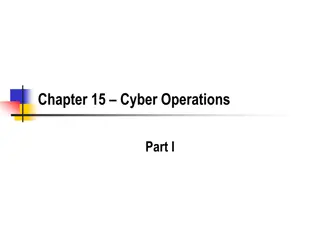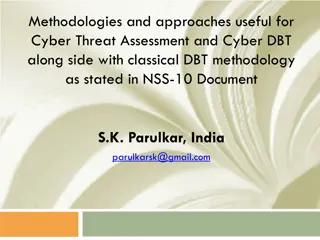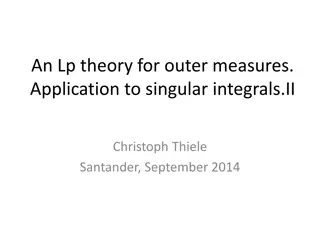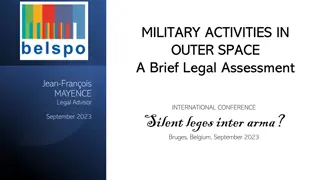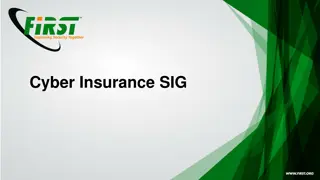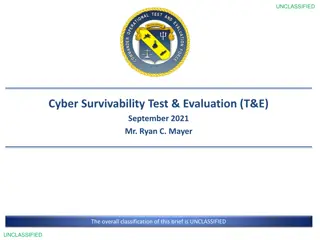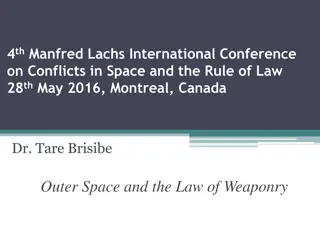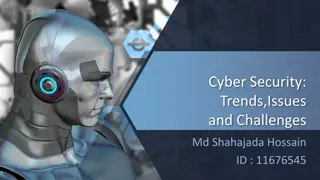Cyber Security in Outer Space: Challenges and Trends
The International Conference on Cyberlaw, Cybercrime & Cybersecurity discussed the ever-growing reliance on outer space by states, organizations, and private actors. With an increasing number of spacefaring states and concerns about militarization, the discussion highlighted weak points, cyber attacks, and the consequences on Earth and space applications.
Download Presentation

Please find below an Image/Link to download the presentation.
The content on the website is provided AS IS for your information and personal use only. It may not be sold, licensed, or shared on other websites without obtaining consent from the author.If you encounter any issues during the download, it is possible that the publisher has removed the file from their server.
You are allowed to download the files provided on this website for personal or commercial use, subject to the condition that they are used lawfully. All files are the property of their respective owners.
The content on the website is provided AS IS for your information and personal use only. It may not be sold, licensed, or shared on other websites without obtaining consent from the author.
E N D
Presentation Transcript
International Conference on Cyberlaw, Cybercrime & Cybersecurity Cyber Security & Outer Space Elina Morozova Editorial Committee, Expert, MILAMOS Project Head of Int l & Legal Service, Intersputnik IGO 14-16 November 2018, New Delhi, India
Sputnik 1 Sputnik 1, , 1957 - - the world s the world s first satellite, first satellite, the birth of the birth of the the space age space age 1957 What is Outer Space for us Today?
A Multitude of Space Applications An Integral Part of Modern Life
Ever-growing reliance on outer space by States, international organizations, private companies, and individuals Reliance on outer space by States includes its military uses Growing vulnerability
Main Trends Continuous development of new technologies Increasing number of spacefaring States and other space actors, including private actors Rising concerns with regard to militarisation and weaponization in outer space
Conventional Weapons or Cyber Attacks?
Three Groups of Weak Points Satellites Ground stations End-users
Access to data Interference with signals Physical control Range of Threats
Common Cyber Attacks Jamming Spoofing Hacking Hijacking Robbing TT&C
Consequences: in Outer Space and on Earth Space-reliant Civilian applications Critical infrastructure Military capabilities A way out?
Full Protection is Not Feasible Communications with outer space through the radiofrequency spectrum Radiofrequency spectrum is the fundamental building block of cyberspace
Space Activities A generic notion which includes exploration and use of outer space, as well as activities on Earth Cyber activities in, from, or through outer space, or with effect in outer space, can be encompassed by the notion of space activities Cyber Activities
Legal Framework Space activities are to be carried in accordance with international law, including the Charter of the United Nations International space law is lex specialis which prevails over the other rules of international law applicable to space-related cyber activities
International Space Law The five United Nations treaties on outer space Outer Space Treaty, 1967 Rescue Agreement, 1968 Liability Convention, 1972 Registration Convention, 1975 Moon Agreement, 1979
Peaceful Purposes The core principle of international space law Under discussion since the beginning of the space age military non-peaceful
Moon and other celestial bodies Shall be used exclusively for peaceful purposes No military activities, including military cyber activities, no offensive cyber operations Non-military peaceful cyber activities are permitted
Example to Follow Cyber capabilities applied to aviation should be used exclusively for peaceful purposes and only for the benefit of improving safety, efficiency and security (Declaration on Cybersecurity in Civil Aviation Dubai, United Arab Emirates, 2017)
Cooperation & Mutual Assistance In the exploration and use of outer space States shall be guided by the principle of cooperation and mutual assistance
Due Regard States shall conduct all their activities in outer space with due regard to the corresponding interests of other States
Jurisdiction and Control A State on whose registry an object launched into outer space is carried retains jurisdiction and control over such object, and over any personnel thereof, while in outer space or on a celestial body
Authorization and Continuing Supervision The activities of non- governmental entities in outer space shall require authorization and continuing supervision by the appropriate State
Responsibility for National Space Activities States bear international responsibility for national activities in outer space and for assuring that they are carried out in conformity with the Outer Space Treaty
Responsibility for National Space Activities State A State B State D State C Launching State, State of Registry
Liability for Damage Caused by a Space Object Fault-based liability State A State B State D State C Launching State, State of Registry Absolute liability
April 2018, Report of the Legal Subcommittee, COPUOS Some delegations expressed the view that the issue of cybersecurity and constant scientific and technological advances were creating conditions that had not been foreseen when the space treaties were negotiated
All these and other complicated issues are discussed in MILAMOS What is the MILAMOS Project?
Mission To develop a manual clarifying the existing international law applicable to military uses of outer space, which encompass space-related military cyber activities, in time of peace, including the times of rising tensions, and, if appropriate, in times of armed conflict
What is a Manual? A collectively agreed text produced by an international group of experts, acting in their personal capacity, with inputs from States and other contributors Contains rules accompanied by commentaries, developed on the basis of lex lata A neutral, objective, and accurate statement of the applicable law
Support and Involvement Strong interest in participation by some world s leading technical and legal experts Recognition and support from the Government of Canada Financial support from the Erin JC Arsenault Fund at McGill University, the Social Sciences and Humanities Research Council of Canada, and ROOM, the Space Journal Endorsed by the Secure World Foundation, the Institute for Defence Studies and Analyses, etc. Involvement of experts from defence forces from several States, including the US, Germany, and France
Experts and Contributors Beijing Institute of Technology, China Canadian Armed Forces, Canada Cologne Institute of Air and Space Law, Germany Federal Ministry of Defense, Germany French Joint Space Command, France German Armed Forces, Germany Harvard-Smithsonian Center for Astrophysics, USA Institute for Defence Studies and Analyses, India Keio University, Japan Interdisciplinary Cyber Research Center, Tel Aviv University, Israel Intersputnik IGO, headquartered in Russia Secure World Foundation, USA St. Petersburg State University, Russia St. Thomas University, USA Universidade Cat lica de Santos, Brasil United States Air Force, USA University of Newcastle, Australia Western Sydney University, Australia Wuhang University, China
Rules Under Discussion Military Space Activities Peaceful Purposes Weaponization Electromagnetic Spectrum Harmful Interference Ground Infrastructure Non-State Actors Jamming & Spoofing Navigation Warfare
Innovative way to break the space security deadlock Involve rule-drafting experts from all disciplines and all parts of the world, as well as advisors and external consultants Appeal to common interests and united by common concerns Introduce initiatives that are non-State-centric and break away from geopolitical interests Reach agreement at workshops through consensus
Progress May 2016, Inaugural Plenary Montreal, Canada February 2017, Workshop I Adelaide, Australia June 2017, Workshop II New Delhi, India October 2017, Workshop III Colorado Springs, USA July 2018, Workshop IV Montreal, Canada October-November 2018, Workshop V Beijing, China February-March 2019, Workshop VI Cologne, Germany finalizing the Manual by the end of 2019
The MILAMOS Manual A contribution to a future where space activities are conducted in accordance with the international rules- based global order, without disrupting, and preferably contributing to, the sustainable use of outer space for the benefit of present and future generations of all humanity
For information mcgill.ca/milamos/ @MILAMOSProject @MilamosProject Prof. Ram Jakhu Director: MILAMOS Project Former Director: Institute of Air and Space Law Professor, Faculty of Law McGill University, Montreal, Canada ram.jakhu@mcgill.ca
